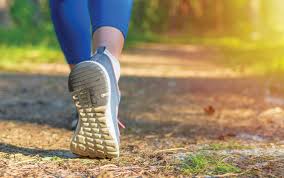Discover the Joy of Walking: Embrace the Benefits of this Simple Exercise

The Benefits of Walking for Your Health
Walking is one of the simplest and most accessible forms of exercise that almost anyone can do. Whether you prefer a leisurely stroll in the park or a brisk walk around your neighborhood, walking offers numerous health benefits that can improve your overall well-being.
Physical Benefits
Regular walking can help you maintain a healthy weight, strengthen your muscles and bones, and improve your cardiovascular fitness. It is a low-impact exercise that is gentle on the joints, making it suitable for people of all ages and fitness levels. Walking also boosts circulation, reduces the risk of chronic diseases such as heart disease and diabetes, and enhances your immune system.
Mental Benefits
Walking is not only good for your body but also beneficial for your mind. It can reduce stress, anxiety, and depression by releasing endorphins, the feel-good hormones. Walking outdoors in nature can have a calming effect on the mind and improve mental clarity. Many people find that walking helps them relax, unwind, and clear their thoughts.
Tips for Getting Started
- Start with short walks and gradually increase the duration and intensity.
- Wear comfortable shoes with good support to prevent injuries.
- Find a walking buddy or join a walking group to stay motivated.
- Set goals for yourself, such as increasing your daily step count or walking a certain distance.
- Explore different routes to keep things interesting and prevent boredom.
Whether you walk for exercise, relaxation, or transportation, incorporating regular walks into your routine can have lasting benefits for your physical and mental health. So lace up your shoes, step outside, and start reaping the rewards of this simple yet powerful form of exercise!
8 Essential Tips for an Effective and Enjoyable Walking Routine
- Wear comfortable and supportive shoes.
- Maintain good posture while walking.
- Warm up before starting a brisk walk.
- Stay hydrated during your walk.
- Incorporate intervals of faster walking for added challenge.
- Use proper form, swing your arms naturally as you walk.
- Choose varied routes to keep things interesting.
- Listen to your body and rest when needed.
Wear comfortable and supportive shoes.
It is essential to wear comfortable and supportive shoes while walking to prevent injuries and ensure a pleasant walking experience. Proper footwear can provide cushioning, stability, and shock absorption, reducing the strain on your feet, ankles, and knees. Shoes with good arch support and a proper fit can help maintain proper alignment and reduce the risk of foot pain or discomfort. Investing in quality walking shoes that are designed for your specific foot type and walking style is crucial for maximizing comfort and preventing potential issues that may arise from inadequate footwear.
Maintain good posture while walking.
Maintaining good posture while walking is essential for maximizing the benefits of this simple yet effective form of exercise. Proper posture not only helps prevent strain on your muscles and joints but also allows for better alignment of your body, leading to improved balance and stability. When walking, focus on keeping your head up, shoulders back and relaxed, and core engaged. By maintaining good posture throughout your walk, you can enhance the efficiency of your movements, reduce the risk of injuries, and promote overall physical well-being.
Warm up before starting a brisk walk.
It is important to warm up before starting a brisk walk to prepare your muscles and joints for the increased activity. A proper warm-up routine can help prevent injuries and improve your overall performance during the walk. Begin with some light stretching exercises to loosen up your muscles and increase blood flow to the areas that will be engaged during the walk. Taking a few minutes to warm up can make a significant difference in how you feel during and after your brisk walk, ensuring a more enjoyable and effective workout.
Stay hydrated during your walk.
It is important to stay hydrated during your walk to ensure optimal performance and prevent dehydration. Drinking water before, during, and after your walk helps regulate your body temperature, lubricate your joints, and transport nutrients to your muscles. Carry a reusable water bottle with you and take small sips regularly to stay hydrated throughout your walk. Remember that even mild dehydration can affect your energy levels and overall well-being, so make hydration a priority during your walking routine.
Incorporate intervals of faster walking for added challenge.
Incorporating intervals of faster walking into your routine can add a new level of challenge and intensity to your workout. By alternating between a brisk pace and a slower pace, you can increase your heart rate, burn more calories, and improve your cardiovascular fitness. These intervals also help to boost your metabolism and strengthen different muscle groups in your legs. Adding this variation to your walking routine not only keeps things interesting but also enhances the overall effectiveness of your workout.
Use proper form, swing your arms naturally as you walk.
When walking, it is important to maintain proper form and swing your arms naturally. Keeping a good posture and allowing your arms to move freely can help you walk more efficiently and reduce strain on your body. By swinging your arms in sync with your steps, you engage additional muscles and improve your overall balance and coordination. Remember to keep your shoulders relaxed and avoid tensing up, allowing for a smooth and comfortable walking experience.
Choose varied routes to keep things interesting.
Selecting diverse routes while walking can help maintain your interest and motivation. By exploring different paths, you can discover new sights, sounds, and experiences that keep your walks fresh and engaging. Whether it’s a scenic trail through the woods, a bustling urban street, or a peaceful waterfront promenade, varying your routes adds excitement and adventure to your walking routine. This variety not only prevents monotony but also stimulates your mind and senses, making each walk a unique and enjoyable experience.
Listen to your body and rest when needed.
Listening to your body is essential when it comes to walking for exercise. Pay attention to how you feel during your walks and don’t hesitate to rest when needed. If you experience any pain, fatigue, or discomfort, it’s important to take a break and allow your body time to recover. Resting when needed helps prevent injuries and allows your muscles to recover and strengthen. By listening to your body and honoring its signals, you can ensure a safe and enjoyable walking experience that promotes overall health and well-being.
